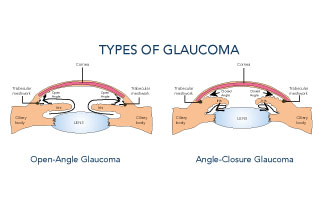The goal of glaucoma treatment is to lower your intraocular pressure by helping fluid to drain. When the pressure is elevated, it can push on your optic nerve – leading to vision damage. A variety of medicated eye drops can be prescribed to reduce the pressure levels, but they aren’t effective for everyone, especially when pressure levels are very high and need to be lowered quickly or sometimes medicine causes serious side effects, such as hypertension, which makes it a poor option for glaucoma treatment.
In certain cases, your River Place Vision Center eye doctor may recommend glaucoma surgery.

Types of Glaucoma Surgery
Typically, your eye doctor will perform laser surgery first. These procedures are done on an outpatient basis.
Laser surgeries for glaucoma include:
- Argon laser trabeculoplasty (ALT): This procedure opens blockages in your eye, allowing fluid to drain properly.
- Selective laser trabeculoplasty (SLT): when ALT isn’t fully effective, this procedure may be used. SLT works by aiming a precisely targeted low-level laser at only the spots with elevated pressure.
- Laser peripheral iridotomy (LPI): when the gap between your iris and cornea is smaller than normal, narrow-angle glaucoma may develop. With this kind of glaucoma, fluid and pressure build up in this small area of the eye. Using a laser beam, LPI creates a tiny hole in the iris through which the excess fluid can drain.
- Cyclophotocoagulation: when all other laser treatments do not relieve the fluid buildup and lower pressure, cyclophotocoagulation may be used. This operation aims a laser beam through the sclera and into the ciliary body, which is the part of the eye that produces intraocular fluid. The laser damages the ciliary body so it makes less eye fluid. Cyclophotocoagulation may be repeated over time to keep pressure levels normal.
Conventional non-laser glaucoma surgery:
If laser surgery doesn’t alleviate eye pressure, you may need a different type of procedure.
- Trabeculectomy: a small incision will be made in the white part of your eye to remove some of the inner mesh of tissue, helping the excess fluid to drain. Medication to prevent scar tissue may also be administered. Research shows that this procedure lowers eye pressure in 6-8 out of 10 people and may be most effective in people who haven’t had previous eye trauma or surgery (for glaucoma, retina surgery, cataracts, or eye muscle problems).
- Drainage implant surgery: a tiny tube will be inserted inside your eye to facilitate fluid draining. Many minimally invasive implants are now available.
- Electrocautery: a heat device, called a Trabectome, is used to make a small incision in the drainage tubes of your eye, which sends heat to the inner mesh of tissue and relieves fluid pressure. Electrocautery is less invasive than trabeculectomy or drainage implants.

Risks of Glaucoma Surgery
Benefits of Glaucoma Surgery
The primary risk of glaucoma surgery is that it increases your chances of developing cataracts later on. Other possible risks include:
- Red eyes
- Eye pain
- Abnormal eye pressure – too high, or even too low
- Vision loss
- Eye infection
- Inflammation or bleeding in your eye
When other types of glaucoma treatment are ineffective or unsuitable, glaucoma surgery offers an excellent alternative to prevent damage to your optic nerve and vision loss.
Also, if the opening in your eye begins to close up again, glaucoma surgery can be repeated. If you’ve already lost vision due to glaucoma, surgery will not be able to restore it – but it can prevent further damage and save your remaining sight!
For glaucoma diagnosis and management, be sure to visit our eye doctors for regular comprehensive eye exams.








